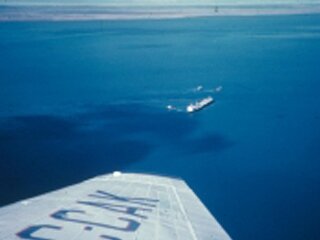METULA, Chile, 1974
9 August 1974

Incident
METULA grounded in the eastern Strait of Magellan on 9th August 1974. Around 47,000 tonnes of light Arabian crude oil and 3,000 to 4,000 tonnes of heavy fuel oil are estimated to be have been lost. Large volumes of water-in-oil emulsion were produced in the rough sea conditions and much of this landed on shores of northern Tierra del Fuego. Most of the shores affected were of mixed sand and gravel, but two small estuaries including saltmarshes were also oiled. About 4,000 birds are known to have been killed, including cormorants and penguins.
Response
No clean-up was carried out due to the remoteness of the area impacted. Consequently, there have been substantial long-term effects from the heavy oiling, which have been extensively investigated over the years. One very sheltered marsh received thick deposits of emulsion and 20 years after the spill, these deposits were still visible on the marsh surface. Another investigation also found oil to still be present over 40 years later. Within the first 20 years following the spill, little plant re-colonisation had occurred in the areas with thicker deposits of 4cm or more. However, over 40 years on, vegetation has recovered to an estimated 75% in interior marsh areas.
ITOPF Involvement
ITOPF was present and onsite during response.
Selected Bibliography
- Guzman, L. and Campodonico, I. (1981). Studies after the Metula oil spill in the Straits of Magellan, Chile. In Proceedings of the Petromar '80 Conference, Monaco, 363-376. Graham and Trotman Ltd., London, UK
- Owens, E. H., Robson, W. and Humphrey, B. (1987). Observations from a site visit to the Metula spill 12 years after. Spill Technology Newsletter 12, 83-96
- Gundlach, E.R. (2017). The great patagonian oil spill (Metula), 41 years later. International Oil Spill Conference Proceedings, 2017(1), pp. 515–535. Available at: https://doi.org/10.7901/2169-3358-2017.1.515
Categories: Chile, Oil, Oil Tanker, Americas, Fate of Oil Spills, Environmental effects
